While you might think adding plants to your kitchen creates unnecessary clutter, the right greenery can actually enhance both functionality and aesthetics in your cooking space. You’ll discover how carefully selected plants can purify air, provide fresh herbs, and transform unused spaces into vibrant focal points. From compact windowsill gardens to innovative vertical solutions, these eight plant ideas will help you maximize your kitchen’s potential without sacrificing precious counter space.
Contents
- 1 Herb Garden Window Box: Fresh Flavors at Your Fingertips
- 2 Hanging Air Plants for Space-Saving Style
- 3 Compact Succulents for Sunny Countertops
- 4 Vertical Garden Wall Solutions
- 5 Potted Aromatics for Natural Kitchen Fragrance
- 6 Low-Light Plants for Dark Kitchen Corners
- 7 Edible Microgreens Display
- 8 Air-Purifying Kitchen Plants
Herb Garden Window Box: Fresh Flavors at Your Fingertips
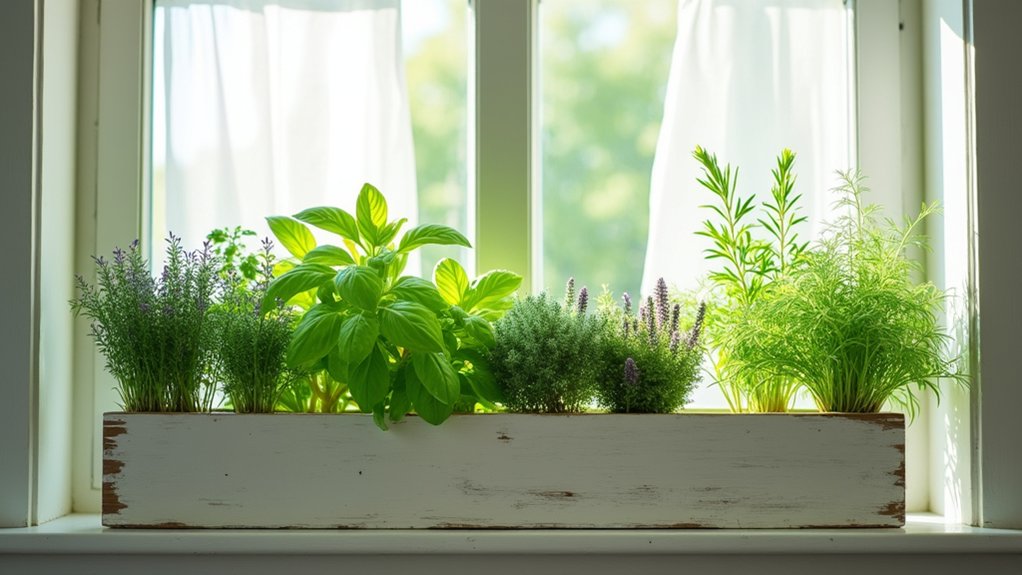
A kitchen herb garden window box transforms an ordinary windowsill into a vibrant, functional growing space that provides fresh herbs within arm’s reach while cooking.
These boxes typically span the width of the window and feature multiple compartments or a single long planter filled with culinary favorites like basil, thyme, parsley, and chives. The setup combines decorative appeal with practical benefits, as the herbs add natural greenery to the kitchen while offering fresh flavors for daily cooking.
- Requires 4-6 hours of direct sunlight daily, preferably from a south-facing window
- Well-draining potting soil mixed with 30% perlite for proper aeration
- Temperature range between 65-75°F (18-24°C)
- Moderate watering when top inch of soil feels dry
- Minimum 6-inch soil depth for proper root development
- Humidity levels between 40-60%
- Container must have drainage holes
Regular pruning is essential for maintaining a healthy window box herb garden.
Harvest herbs frequently to encourage bushier growth, and remove any yellowing or dead leaves promptly.
Rotate the container quarter-turns weekly to ensure even growth, as plants naturally lean toward light sources.
Feed with a balanced, water-soluble fertilizer monthly during growing season, and trim back aggressive growers to prevent them from overshadowing smaller herbs.
Hanging Air Plants for Space-Saving Style
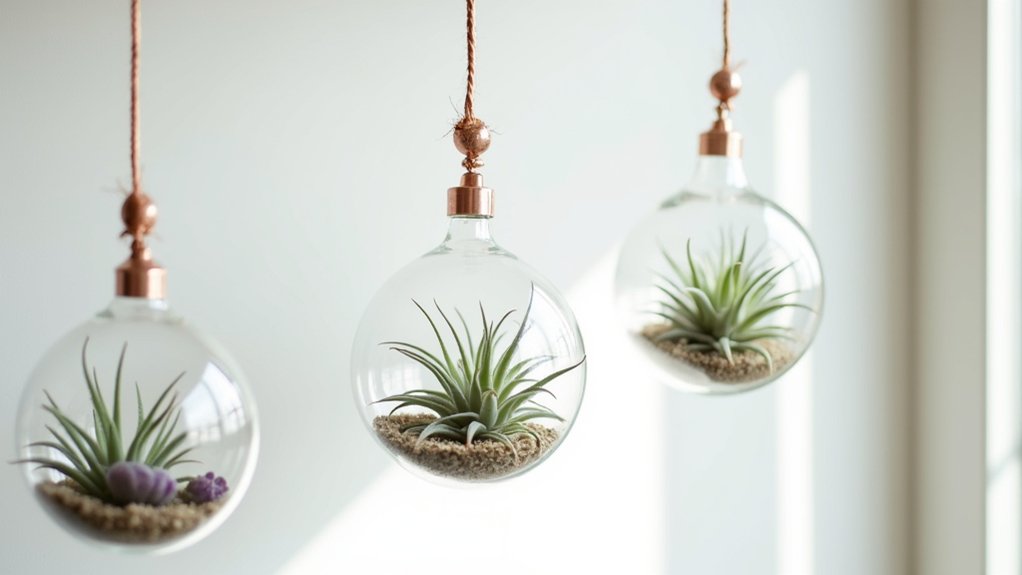
Hanging air plants (Tillandsia) offer an innovative way to add greenery to your kitchen without taking up valuable counter space. These rootless plants naturally grow attached to other surfaces in their native habitat, making them perfect for suspended displays in glass globes, wall-mounted holders, or macramé hangers.
Their spiky, silvery-green leaves form elegant rosettes that can range from tiny specimens just an inch across to dramatic clusters spanning several inches, with some varieties producing vibrant purple or red blooms when mature.
Growing Conditions:
- Bright, indirect light – avoid direct sunlight which can burn leaves
- No soil needed – absorbs nutrients through leaves
- Humidity level of 50-60% ideal
- Temperature range of 50-90°F (10-32°C)
- Good air circulation essential
- Weekly misting or soaking in room temperature water
Regular grooming and proper watering technique are crucial for air plant survival in kitchen settings.
After watering, plants should be gently shaken to remove excess moisture and placed upside down on a towel to dry completely within 4 hours to prevent rot.
Remove any dead or browning leaves at the base, and rotate displays periodically to ensure even light exposure.
Fertilize monthly during growing season with air plant-specific fertilizer at 1/4 strength to promote healthy growth and potential blooming.
Compact Succulents for Sunny Countertops

Compact succulents are perfect additions to sunny kitchen countertops, offering architectural interest in small spaces without overwhelming the work area. These miniature plants come in various shapes, colors, and textures, from rosette-forming echeverias to chunky jade plants and diminutive aloe varieties. Their thick, fleshy leaves store water efficiently, making them naturally adaptable to indoor environments while adding a modern, low-profile aesthetic to kitchen decor.
- Light: Bright, indirect sunlight; minimum 4-6 hours daily; south or west-facing windows ideal
- Water: Allow soil to dry completely between waterings; reduce watering in winter
- Soil: Well-draining cactus or succulent mix
- Temperature: 65-80°F (18-27°C)
- Humidity: Low to moderate; tolerates typical kitchen conditions
- Container: Small pots with drainage holes; ceramic, terra cotta, or concrete preferred
- Space: 4-8 inches of growing room per plant
Regular maintenance focuses on preventing common issues rather than constant care. Remove any dried or yellowing leaves promptly to prevent rot and pest problems.
Rotate containers quarter-turn weekly to ensure even growth, and dust leaves gently with a soft brush to maintain their natural protective coating. Prune overgrown stems to maintain compact shape, and check regularly for signs of stretching, which indicates insufficient light.
Wait until soil is completely dry before repotting, typically needed every 2-3 years.
Vertical Garden Wall Solutions
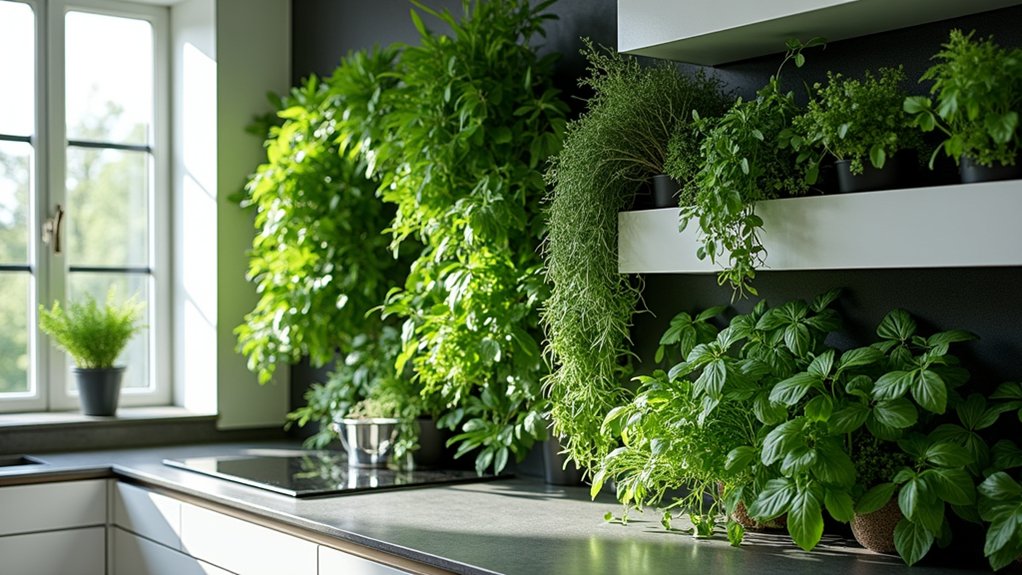
Vertical garden walls transform kitchen spaces by creating living tapestries of herbs, succulents, or leafy greens that grow upward instead of outward. These space-saving installations can range from simple pocket planters mounted on walls to elaborate hydroponic systems, offering both aesthetic appeal and functional growing space.
Modern vertical gardens often incorporate modular designs with individual planting cells, mesh systems, or repurposed pallets, allowing for easy plant arrangement and replacement.
- Light: Requires 4-6 hours of direct sunlight daily; south or west-facing walls are optimal
- Water: Drip irrigation system or manual watering 2-3 times weekly; ensure proper drainage
- Soil: Well-draining potting mix with organic matter; lightweight soilless media for hydroponic systems
- Temperature: 65-80°F (18-27°C) for most kitchen herbs and vegetables
- Humidity: 40-60% relative humidity; may need supplemental misting
- Spacing: 6-12 inches between plants, depending on mature size
Regular maintenance of vertical garden walls involves pruning overgrown plants, replacing failing specimens, and checking irrigation systems weekly.
Rotate plants periodically to ensure even growth and prevent shadowing of lower specimens. Monitor plant roots for signs of binding or overcrowding, and trim back as needed.
Keep the structure secure by checking mounting hardware monthly and clean any drip trays or drainage channels to prevent water damage to walls.
Potted Aromatics for Natural Kitchen Fragrance
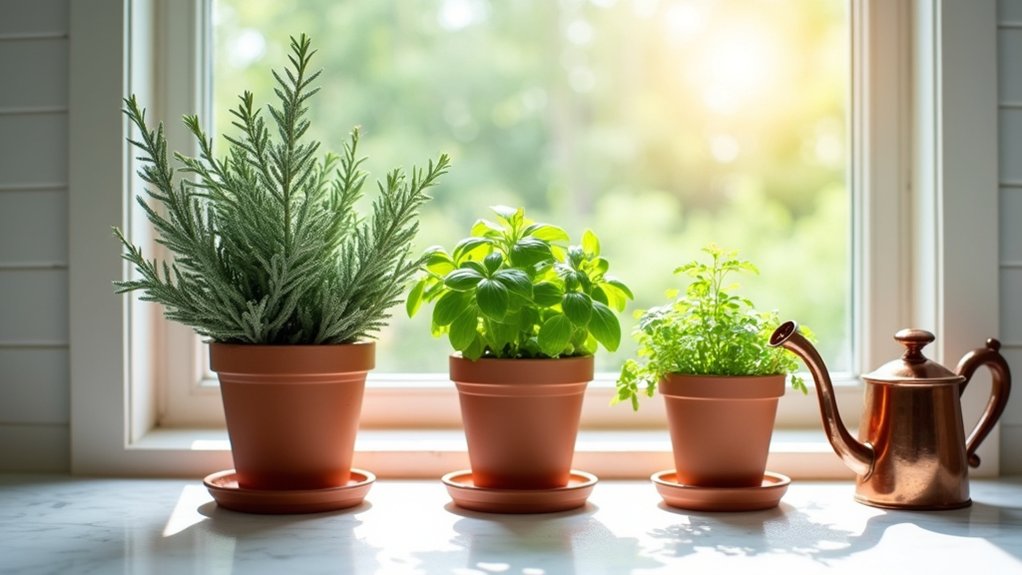
Potted aromatic plants bring both natural fragrance and culinary functionality to kitchen spaces. These herbs and plants, such as basil, rosemary, mint, and lavender, offer varying heights, textures, and delightful scents that can help neutralize cooking odors while providing fresh ingredients for meals.
Their compact growing habits make them ideal for windowsills, countertops, or hanging planters, creating an attractive and practical display that enhances the kitchen’s atmosphere.
Growing Conditions:
- Light: 6-8 hours of direct sunlight daily, preferably from a south-facing window
- Water: Moderate watering when top inch of soil feels dry
- Soil: Well-draining potting mix with added perlite
- Temperature: 65-70°F (18-21°C)
- Humidity: 40-50% relative humidity
- Container: Pots with drainage holes, sized appropriately for each plant
- Spacing: 6-12 inches between plants, depending on variety
Regular pruning encourages bushier growth and prevents flowering, which maintains the plants’ aromatic properties and extends their productive life.
Rotate pots quarterly to ensure even growth, and fertilize monthly during growing season with a balanced, water-soluble fertilizer.
Remove yellowing or dead leaves promptly to prevent disease spread, and consider placing pots on humidity trays filled with pebbles and water to maintain adequate moisture levels, especially during winter months when indoor heating can create dry conditions.
Low-Light Plants for Dark Kitchen Corners
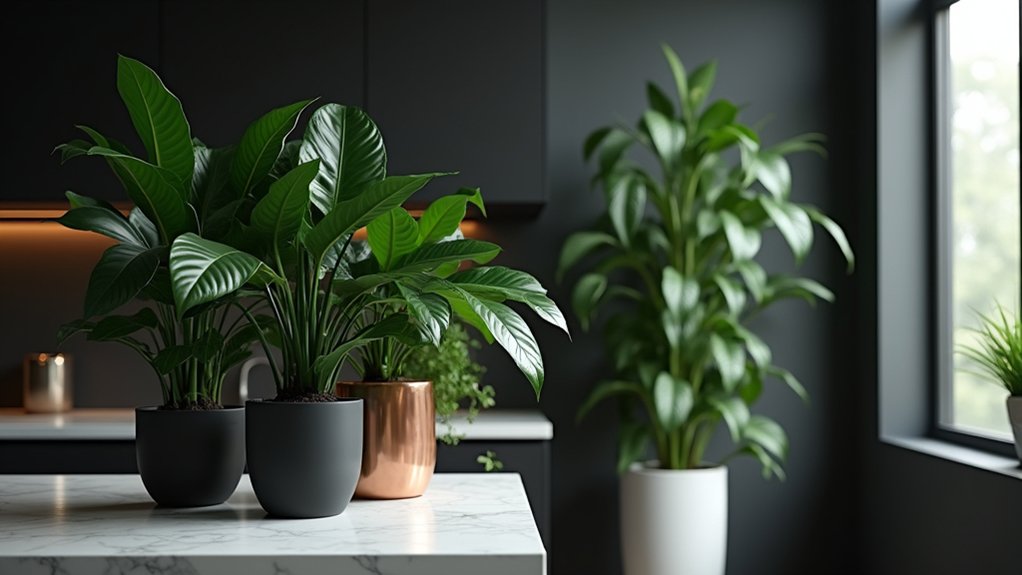
Dark kitchen corners don’t have to remain bare, as several resilient houseplants thrive in low-light conditions.
These shade-tolerant plants typically feature broad, dark green leaves that efficiently capture and utilize minimal light. Many low-light plants have adapted to grow naturally under dense forest canopies, making them perfectly suited for dimly lit kitchen spaces where natural light is limited or filtered.
- Light Requirements: Tolerates 50-75 feet from windows; avoids direct sunlight
- Water Needs: Moderate watering when top inch of soil feels dry
- Soil Type: Well-draining potting mix rich in organic matter
- Humidity: Prefers 40-50% humidity levels
- Temperature: Comfortable in standard room temperatures (60-75°F)
- Container: Pots with drainage holes to prevent root rot
- Fertilizer: Light feeding with balanced houseplant fertilizer every 2-3 months
Regular dusting of leaves with a damp cloth helps maximize light absorption and photosynthesis efficiency.
Rotating plants quarterly ensures even growth, while pruning yellowed or damaged leaves maintains plant health and appearance.
Watch for signs of overwatering, such as leaf yellowing or drooping, and adjust care accordingly.
Group plants together to create humidity pockets and enhance their growing environment naturally.
Edible Microgreens Display

A microgreens display brings both culinary functionality and visual appeal to your kitchen, featuring tiny, tender seedlings of various edible plants arranged in shallow trays or containers. These vibrant mini-gardens typically showcase an assortment of young vegetable and herb shoots, from spicy radish sprouts to delicate cilantro seedlings, creating a living tapestry of different colors, textures, and heights.
The display can be arranged on windowsills, countertops, or mounted on walls using specialized growing systems, making it both a practical food source and an attractive kitchen accent.
- Light Requirements: 4-6 hours of direct sunlight daily or 12-16 hours under grow lights
- Soil: Well-draining, sterile seed-starting mix, about 1-2 inches deep
- Water: Keep soil consistently moist but not waterlogged
- Temperature: 65-75°F (18-24°C)
- Container: Shallow trays with drainage holes
- Growing Time: 7-21 days from seed to harvest
- Spacing: Seeds can be densely sown, about 1/4 inch apart
Regular harvesting is essential for maintaining a productive microgreens display, with most varieties ready to cut when they develop their first true leaves.
Rotate crops by starting new seeds every 1-2 weeks to ensure continuous production, and thoroughly clean trays between plantings to prevent mold growth. Monitor for adequate air circulation, trim any yellowing leaves promptly, and avoid overwatering to prevent damping-off disease.
When harvesting, use clean, sharp scissors and cut just above the soil line to maintain cleanliness and prevent contamination.
Air-Purifying Kitchen Plants
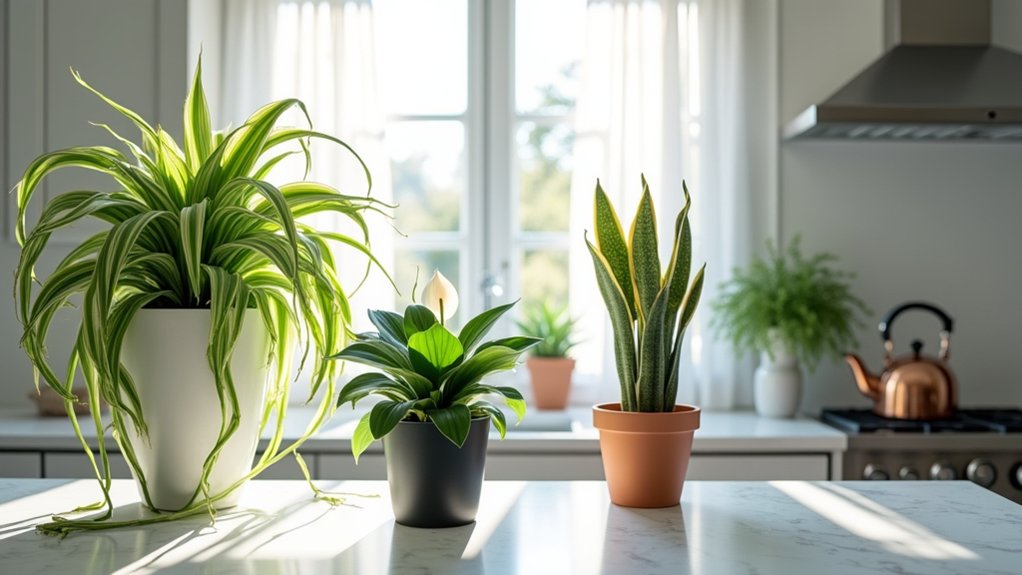
Air-purifying kitchen plants are specialized indoor varieties that excel at removing common household pollutants while adding natural beauty to cooking spaces.
These plants, such as spider plants, peace lilies, and snake plants, actively filter harmful compounds like formaldehyde, benzene, and carbon monoxide that can be released during cooking. Most air-purifying kitchen plants feature broad leaves or multiple fronds to maximize their air-cleaning capabilities, and many have adaptable growth patterns that work well in various kitchen spaces, from countertops to hanging baskets.
- Light Requirements: Moderate to bright indirect light; avoid direct sunlight
- Water Needs: Regular watering when top inch of soil feels dry
- Soil Type: Well-draining potting mix with good aeration
- Humidity: 40-60% relative humidity
- Temperature: 65-80°F (18-27°C)
- Container: Pots with drainage holes
- Spacing: Allow room for air circulation between plants
To maintain optimal air-purifying performance, regularly dust leaves with a damp cloth to keep pores unclogged and remove accumulated particles.
Trim yellowing or dead foliage promptly to prevent energy waste and maintain aesthetics. Rotate plants quarterly to ensure even growth and air-cleaning effectiveness, and consider grouping multiple air-purifying plants together to create a more powerful natural filtration system.
Monthly fertilization during growing season will support robust growth and maintain the plant’s air-cleaning capabilities.
